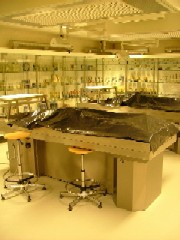Accidental Discoveries: The True Stories Behind Five of Our Favorite Products
in Science Trivia No Comments »Not all of the world’s most brilliant innovations were intentional. In many cases, an accident or mistake led to some creative thinking, which eventually became a new, hot product.
Such is the case with these products.
 The Post-It® Note
The Post-It® Note
A 3M engineer named Spencer Silver was working one night in 1968. His goal was to invent a strong adhesive. Instead, he came up with the reusable “ but quite weak “ adhesive that a fellow 3M engineer by the name of Arthur Fry would eventually turn into a bookmark. That became the Post-It® Note.
By 1980, the Post-It® Note was available all over the world. Today, the 3M company markets some 200 products that contain Silver’s accidental invention: the adhesive that has made the company a sizable fortune.
Read the rest of this entry »
 Take an organism and surgically install a backpack of electrodes and a microprocessor to its thorax. Now use a remote control to send signals to the backpack to control the creature’s movements. If you equip enough organisms in this manner, and if they are large and powerful enough, and your method of control contains enough accuracy, you could potentially use your robot-creatures to take over the entire Earth. But if the creatures you’re using are only cockroaches, the most you’ll be able to do is make them to crawl into tight spaces, do some surveillance work, and perhaps rescue a few victims of natural disasters – very important tasks.
Take an organism and surgically install a backpack of electrodes and a microprocessor to its thorax. Now use a remote control to send signals to the backpack to control the creature’s movements. If you equip enough organisms in this manner, and if they are large and powerful enough, and your method of control contains enough accuracy, you could potentially use your robot-creatures to take over the entire Earth. But if the creatures you’re using are only cockroaches, the most you’ll be able to do is make them to crawl into tight spaces, do some surveillance work, and perhaps rescue a few victims of natural disasters – very important tasks. An autopsy is a procedure performed on a non-living body in order to learn valuable clues as to the cause death. The word ‘autopsy’ comes from the Greek words ‘auto’ and ‘opsis’, meaning ‘to see for oneself’. Who performs autopsies and how? Why does it take so long to receive results, and how is the determination of death made? To understand the answers to these questions, an explanation of the procedure known as an autopsy is helpful.
An autopsy is a procedure performed on a non-living body in order to learn valuable clues as to the cause death. The word ‘autopsy’ comes from the Greek words ‘auto’ and ‘opsis’, meaning ‘to see for oneself’. Who performs autopsies and how? Why does it take so long to receive results, and how is the determination of death made? To understand the answers to these questions, an explanation of the procedure known as an autopsy is helpful. In the last 30 years, the world has experienced an infusion of technology all stemming from the inception of the computer. Where were you when all this was happening?
In the last 30 years, the world has experienced an infusion of technology all stemming from the inception of the computer. Where were you when all this was happening? Pheromones are a natural chemical occurrence in humans and animals that essentially attract a member of the opposite sex. This reaction happens instantaneously and can directly affect the other person with or without their knowledge.
Pheromones are a natural chemical occurrence in humans and animals that essentially attract a member of the opposite sex. This reaction happens instantaneously and can directly affect the other person with or without their knowledge. Cryonics is the practice of storing human bodies in a deep freeze state in hopes that they can be revived sometime in the future. The mentality of scientists who practice cryonics is that if a human being dies of an incurable disease today, the body can be frozen until a cure is found. At that time, the body would be thawed, revived and treated. This type of preservation is called, “cryonic suspension.”
Cryonics is the practice of storing human bodies in a deep freeze state in hopes that they can be revived sometime in the future. The mentality of scientists who practice cryonics is that if a human being dies of an incurable disease today, the body can be frozen until a cure is found. At that time, the body would be thawed, revived and treated. This type of preservation is called, “cryonic suspension.” Just the word NanoTechnology conjures up images of future technologies that will undoubtedly change the way of the world, and to some extent this is true. NanoTechnology will change the way of the world and in many different areas but it is already being developed and improved as you read this article. NanoTechnology is simply technology at its smallest. While microchips in computers, television, DVD players and other electrical and electronic equipment may seem small now you wait until you see a nanochip. That’s presuming you can see it.
Just the word NanoTechnology conjures up images of future technologies that will undoubtedly change the way of the world, and to some extent this is true. NanoTechnology will change the way of the world and in many different areas but it is already being developed and improved as you read this article. NanoTechnology is simply technology at its smallest. While microchips in computers, television, DVD players and other electrical and electronic equipment may seem small now you wait until you see a nanochip. That’s presuming you can see it. Stem cells are individual cells that have a high level of plasticity. This plasticity means that they can grow or transform into not only other cells, but also tissue and even organs that the body requires. While a stem cell is initially useless, they act like a blank cell that can be converted to perform any number of tasks within the body. Stem cells are abundant in embryos and very young infants, and until recently it was believed that they were only present in bone marrow and skin within adults. However, recent research has shown that adult stem cells are also present in the brain randomly surrounded by millions of other cells that cannot be disturbed.
Stem cells are individual cells that have a high level of plasticity. This plasticity means that they can grow or transform into not only other cells, but also tissue and even organs that the body requires. While a stem cell is initially useless, they act like a blank cell that can be converted to perform any number of tasks within the body. Stem cells are abundant in embryos and very young infants, and until recently it was believed that they were only present in bone marrow and skin within adults. However, recent research has shown that adult stem cells are also present in the brain randomly surrounded by millions of other cells that cannot be disturbed. Science is a broad term covering a myriad of subjects including weather, physics, chemistry, geology, biology, zoology, etc… The following facts all relate to this larger world of science.
Science is a broad term covering a myriad of subjects including weather, physics, chemistry, geology, biology, zoology, etc… The following facts all relate to this larger world of science. Hot Air Balloons have 3 basic compartments that make up their design. They are the envelope, basket, and burners.
Hot Air Balloons have 3 basic compartments that make up their design. They are the envelope, basket, and burners. Did you know there are different types of ice? Or that the area of ice in the Arctic is at a worryingly low level? It’s true – read on to discover this, plus more fascinating facts about ice!
Did you know there are different types of ice? Or that the area of ice in the Arctic is at a worryingly low level? It’s true – read on to discover this, plus more fascinating facts about ice!